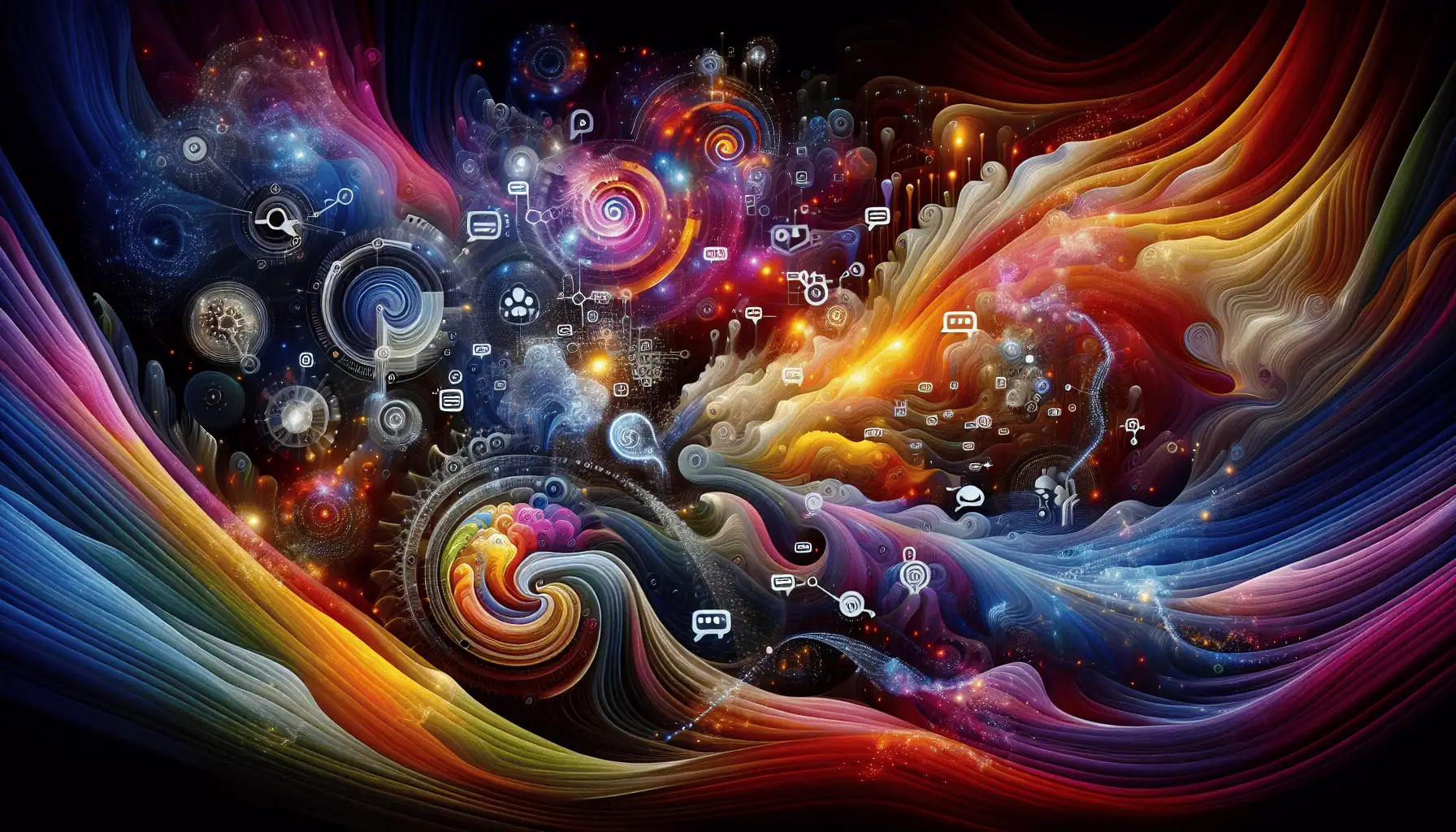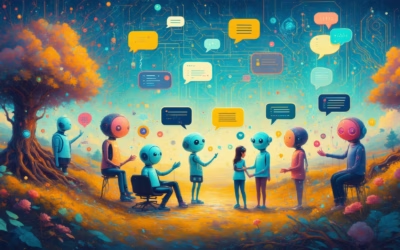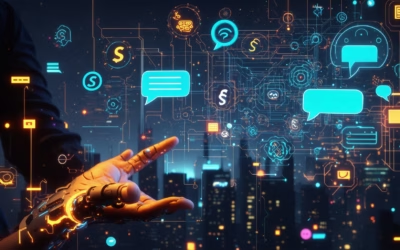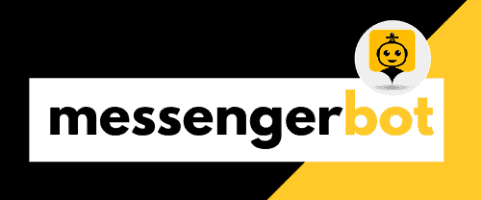In today’s digital landscape, understanding the chatbot features comparison is essential for businesses looking to enhance customer engagement and streamline operations. This comprehensive guide will delve into the key features of chatbots, exploring their capabilities and the essential functionalities that make them indispensable tools for modern enterprises. We will also examine the four main types of chatbots, comparing various platforms to highlight their strengths and weaknesses. As we evaluate options, including which chatbot might outperform ChatGPT, we will identify the most powerful AI chatbots available and provide a detailed comparison table showcasing performance metrics. Additionally, we will discuss the critical features that drive user experience and engagement, along with best practices for successful chatbot implementation. For those on a budget, our section on free chatbot features comparison will reveal the best chatbot solutions that deliver value without breaking the bank. Join us as we uncover the best AI chats and help you navigate the evolving world of chatbots to find the perfect fit for your business needs.
What are the key features of a chatbot?
Understanding chatbot capabilities
AI chatbots have transformed the landscape of digital communication, offering a range of capabilities that enhance user interaction and streamline business processes. One of the primary advantages of utilizing a chatbot platform is its ability to improve efficiency and productivity. By automating repetitive tasks, AI chatbots allow human agents to concentrate on more complex inquiries, leading to a significant increase in productivity. According to a study by McKinsey, businesses can boost productivity by up to 40% through automation (McKinsey & Company, 2021).
Moreover, chatbots provide 24/7 support, ensuring that customers receive assistance at any time, even outside regular business hours. This constant availability can lead to higher customer satisfaction and retention rates, as highlighted in a report by HubSpot (HubSpot, 2022). The use of natural language processing (NLP) further enhances engagement, enabling chatbots to understand and respond to customer queries in a conversational manner. Research from Salesforce indicates that 69% of consumers prefer chatbots for quick communication (Salesforce, 2023).
Essential features of chatbots for businesses
When evaluating the essential features of chatbots for businesses, several key elements stand out. First, the ability to provide self-service options empowers users to resolve issues independently through FAQs and guided troubleshooting. A study by Forrester found that 72% of customers prefer self-service options over speaking to a representative (Forrester, 2022).
Additionally, personalization is a crucial feature, as advanced chatbots can analyze user data to deliver tailored responses and recommendations. According to a report by Accenture, 91% of consumers are more likely to shop with brands that provide relevant offers and recommendations (Accenture, 2023). Integration with other systems, such as CRM platforms, is also vital, allowing chatbots to access customer history and provide personalized support, as noted by Zendesk (Zendesk, 2023).
Finally, the cost-effectiveness of implementing AI chatbots cannot be overlooked. By minimizing the need for large customer service teams, businesses can significantly reduce operational costs. A study by Juniper Research estimates that chatbots will help businesses save over $8 billion annually by 2022 (Juniper Research, 2021). These features collectively position chatbots as essential tools for enhancing customer service and driving business growth.
What are the 4 types of chatbots?
Understanding the different types of chatbots is crucial for businesses looking to enhance their customer engagement strategies. Each type offers unique capabilities and can be tailored to meet specific needs. Here’s an overview of the four primary types of chatbots:
Overview of chatbot types
1. Menu-based Chatbots: These are the simplest form of chatbots, providing users with predefined options to choose from. They guide users through a series of menus to help them find information or complete tasks. Commonly used in customer service, menu-based chatbots enhance user experience by simplifying navigation.
2. Rule-based Chatbots: Building on the foundation of menu-based chatbots, rule-based chatbots utilize a more complex decision tree structure. They operate on a set of predefined rules and can handle specific queries by following an if/then logic. While they can provide more personalized responses than menu-based chatbots, their capabilities are limited to the scenarios they are programmed to understand.
3. AI-powered Chatbots: These chatbots leverage artificial intelligence and natural language processing (NLP) to understand and respond to user queries in a more human-like manner. They learn from interactions, allowing them to improve over time and handle a wider range of questions. AI-powered chatbots are increasingly used in various sectors, including e-commerce and healthcare, due to their ability to provide personalized assistance.
4. Hybrid Chatbots: Combining the strengths of both rule-based and AI-powered chatbots, hybrid chatbots can switch between scripted responses and AI-driven interactions. This flexibility allows them to handle complex queries while still providing quick answers for straightforward requests. Hybrid chatbots are particularly effective in environments where both efficiency and personalization are essential.
Comparing chatbot platforms: strengths and weaknesses
When evaluating chatbot platforms, it’s essential to consider their strengths and weaknesses to determine which best suits your business needs. For instance, IBM AI chatbots are known for their robust AI capabilities, making them ideal for complex customer interactions. In contrast, Zendesk chat solutions offer excellent integration with customer service tools, enhancing overall support efficiency.
Additionally, Salesforce chatbot features provide seamless integration with CRM systems, making them a strong choice for businesses focused on customer relationship management. Each platform has unique features of chatbots that cater to different operational needs, so it’s crucial to compare chatbots based on your specific requirements.
For a more detailed analysis of chatbot capabilities and to explore various options, check out our top chatbot solutions page.
Which chatbot is better than ChatGPT?
When evaluating AI chatbot options against ChatGPT, it’s essential to consider various factors such as functionality, user experience, and specific use cases. While ChatGPT is a leading AI chatbot known for its conversational abilities, several alternatives offer unique features that may better suit specific needs.
Evaluating AI chatbot options against ChatGPT
Several AI chatbots stand out as viable alternatives to ChatGPT, each with distinct advantages:
- Chatsonic (Best for Voice Chat): Chatsonic excels in voice chat capabilities, integrating seamlessly with various platforms. Its natural language processing offers a conversational experience ideal for interactive applications. (Source)
- Jasper AI (Best for Content Creation): Renowned for generating high-quality written content, Jasper AI is a top choice for marketers. It produces SEO-optimized articles, enhancing online visibility and engagement. (Source)
- Google Bard (Best for Search Integration): Leveraging Google’s search capabilities, Google Bard provides real-time information and contextually relevant responses, making it an excellent choice for users seeking up-to-date insights. (Source)
- Microsoft Bing Chat (Best for Search Queries): This chatbot combines AI with Bing’s search engine, offering accurate answers to queries while providing a conversational interface. Its real-time data retrieval is particularly valuable. (Source)
- Replika (Best for Personal Companionship): Designed for emotional support, Replika engages users in meaningful conversations, adapting to their personality over time, making it ideal for companionship. (Source)
These alternatives highlight the diversity in chatbot capabilities, allowing businesses and individuals to choose based on their specific needs and preferences.
Best AI chatbot free: top contenders
For those seeking the best AI chatbots without financial commitment, several platforms offer robust features at no cost:
- Tidio (Best for Customer Support): Tidio focuses on enhancing customer support experiences, integrating with e-commerce platforms to provide instant responses to inquiries. Its learning capabilities make it a valuable tool for businesses.
- Kuki (Best for Entertainment): Kuki is designed for casual conversation and entertainment, engaging users with humor and personality, making it a fun alternative to traditional chatbots.
- Zoho SalesIQ (Best for Business Integration): Combining AI chatbots with analytics, Zoho SalesIQ enhances customer engagement by providing insights into customer behavior, allowing for tailored interactions.
These free chatbot solutions demonstrate that effective AI chatbots are accessible, offering essential features that can help businesses engage with their audience without incurring costs. For a comprehensive overview of various chatbot platforms, consider exploring our top chatbot solutions article.
Which is the most powerful AI chatbot?
In the rapidly evolving landscape of AI chatbots, identifying the most powerful options is crucial for businesses seeking to enhance their customer interactions. The most powerful AI chatbots of 2025 include ChatGPT, Copilot, and Claude. Each of these chatbots showcases unique features and capabilities that set them apart in the competitive chatbot market.
Features of the most powerful chatbots
The leading AI chatbots are distinguished by their advanced functionalities and user-centric designs. Here’s a closer look at the standout features:
- ChatGPT: Developed by OpenAI, ChatGPT is renowned for its conversational abilities and versatility. It excels in various tasks such as coding, content creation, and research assistance. Its continuous updates and improvements ensure it remains at the forefront of AI technology.
- Copilot: This AI chatbot, integrated into various software applications, is designed to enhance productivity by providing real-time suggestions and automating repetitive tasks. Its ability to learn from user interactions makes it a powerful tool for professionals across different industries.
- Claude: Launched by Anthropic in February 2023, Claude is designed with a strong emphasis on privacy and ethical AI use. It can assist users with a wide range of tasks, including coding, mathematics, writing, and research. Its conversational capabilities are comparable to its leading competitors, making it a formidable option in the AI chatbot landscape.
These chatbots leverage advanced machine learning algorithms and natural language processing techniques, ensuring they provide accurate and contextually relevant responses. For businesses, selecting a powerful AI chatbot can significantly enhance customer engagement and satisfaction.
Chatbot comparison table: performance metrics
To facilitate a better understanding of the capabilities of these leading AI chatbots, a comparison table highlighting key performance metrics can be invaluable. Below is a simplified overview:
| Chatbot | Key Features | Best Use Cases |
|---|---|---|
| ChatGPT | Versatile, continuous updates, strong conversational skills | Content creation, customer support, coding assistance |
| Copilot | Real-time suggestions, task automation, learning capabilities | Productivity enhancement, software integration |
| Claude | Privacy-focused, ethical AI use, broad task assistance | Research, writing, coding |
This chatbot comparison table provides a clear view of how these powerful AI chatbots stack up against each other, helping businesses make informed decisions about which chatbot platform aligns best with their needs.
What is the key feature of chatbot?
Importance of user experience in chatbot features
A key feature of a chatbot is its ability to engage in natural language processing (NLP), allowing it to understand and respond to user inquiries in a conversational manner. This capability is crucial for providing accurate and relevant information, enhancing user experience, and facilitating seamless interactions. The importance of user experience in chatbot features cannot be overstated, as it directly impacts user satisfaction and engagement. Chatbots that effectively utilize NLP and other advanced features can significantly improve the overall interaction quality.
Chatbot capabilities that drive engagement
Several chatbot capabilities are essential for driving user engagement:
- Natural Language Understanding (NLU): This enables chatbots to comprehend user intent and context, making interactions more intuitive. According to a study by IBM, effective NLU can significantly improve user satisfaction by 30% (IBM, 2021).
- Machine Learning Capabilities: Chatbots utilize machine learning algorithms to learn from past interactions, improving their responses over time. This adaptability is essential for maintaining relevance in dynamic environments (Gartner, 2022).
- 24/7 Availability: Chatbots provide round-the-clock support, ensuring users can access information and assistance at any time, which is particularly beneficial for businesses aiming to enhance customer service (Forrester, 2023).
- Integration with Other Systems: Advanced chatbots can integrate with various platforms, such as CRM systems and social media, allowing for a more holistic approach to customer engagement (Salesforce, 2023).
- Personalization: By analyzing user data, chatbots can offer personalized recommendations and responses, enhancing user engagement and satisfaction (McKinsey, 2022).
These features collectively contribute to the effectiveness of chatbots in various applications, from customer service to healthcare, making them invaluable tools in today’s digital landscape. For businesses looking to implement chatbots, understanding these capabilities is essential for selecting the best chatbot solutions that align with their goals.
What makes a successful chatbot?
Best practices for chatbot implementation
To ensure a chatbot’s success, businesses must adhere to several best practices that enhance user engagement and satisfaction. Here are key strategies:
- Understand Customer Intent: A successful chatbot must accurately interpret user queries. This involves utilizing Natural Language Processing (NLP) techniques to analyze common support questions and customer-agent interactions. Research indicates that chatbots with advanced NLP capabilities can improve user satisfaction by up to 30% (Source: McKinsey & Company).
- Provide Contextual Responses: Implementing context-aware responses enhances user experience. By maintaining conversation history, chatbots can deliver personalized answers that reflect previous interactions, leading to a more engaging dialogue (Source: Harvard Business Review).
- Utilize Machine Learning: Incorporating machine learning algorithms allows chatbots to learn from interactions over time, improving their accuracy and efficiency. Studies show that chatbots utilizing machine learning can reduce response times by 50% (Source: Gartner).
- Offer Multichannel Support: A successful chatbot should be accessible across various platforms, including websites, social media, and messaging apps. This omnichannel presence ensures that users can engage with the chatbot wherever they are, increasing overall accessibility (Source: Forrester Research).
- Implement Clear Escalation Paths: While chatbots can handle many inquiries, they should also have a clear protocol for escalating complex issues to human agents. This hybrid approach ensures that customers receive timely and effective support (Source: Zendesk).
- Regularly Update Knowledge Base: Keeping the chatbot’s knowledge base current is crucial. Regular updates based on new products, services, and customer feedback ensure that the chatbot provides accurate and relevant information (Source: HubSpot).
- Measure Performance Metrics: Continuously monitoring key performance indicators (KPIs) such as user satisfaction, resolution time, and engagement rates helps identify areas for improvement. Analytics tools can provide insights into chatbot performance and user behavior (Source: Salesforce).
- Focus on User Experience Design: An intuitive user interface and engaging conversation design are essential for a successful chatbot. Employing user-centered design principles can enhance interaction quality and user retention (Source: Nielsen Norman Group).
Analyzing chatbot features that lead to success
When evaluating chatbot features that contribute to a successful implementation, consider the following:
- Automated Responses: The ability to provide instant, automated replies to user inquiries is fundamental. This feature not only enhances response times but also ensures that users receive immediate assistance.
- Workflow Automation: Successful chatbots can automate workflows based on user interactions, allowing for tailored experiences that improve engagement and satisfaction.
- Lead Generation Capabilities: Many chatbots are designed to assist in lead generation, utilizing interactive messaging strategies to capture user information effectively.
- Multilingual Support: Offering support in multiple languages broadens a chatbot’s reach, making it accessible to a diverse audience and enhancing user experience.
- Analytics and Reporting: Robust analytics features enable businesses to track performance metrics, providing insights that can drive continuous improvement in chatbot functionality.
By focusing on these features and best practices, businesses can create chatbots that not only meet user needs but also drive engagement and satisfaction, ultimately leading to better customer experiences.
Free chatbot features comparison
Exploring free chatbot platforms
When considering a free chatbot platform, it’s essential to evaluate the features that can enhance user engagement and streamline business operations. Many platforms offer robust capabilities without upfront costs, making them ideal for budget-conscious businesses. Key features to look for include:
– **Automated Responses**: Most free chatbot platforms, like Messenger Bot, provide automated responses to user inquiries, ensuring timely engagement.
– **Integration Options**: Look for platforms that easily integrate with existing systems, such as social media and websites, to maximize reach.
– **User Analytics**: Free solutions often include basic analytics to track user interactions, helping businesses refine their strategies.
– **Customization**: The ability to customize the chatbot’s appearance and responses is crucial for maintaining brand identity.
Platforms such as [IBM AI chatbots](https://www.ibm.com/cloud/ai-chatbots) and [Zendesk chat solutions](https://www.zendesk.com/chat/) also offer free tiers with limited features, making them suitable for small businesses or startups looking to test chatbot capabilities.
Best chatbot solutions for budget-conscious businesses
For businesses operating on a tight budget, selecting the best chatbot solution involves comparing the available features and their effectiveness. Here are some of the best options:
– **Messenger Bot**: Known for its user-friendly interface and comprehensive features, Messenger Bot allows businesses to automate responses and manage workflows effectively. Its multilingual support and SMS capabilities make it a versatile choice for diverse audiences.
– **Tidio**: This platform offers a free plan with essential features such as live chat and automated responses, making it a great entry point for small businesses.
– **Chatfuel**: A popular choice among marketers, Chatfuel provides a free version that enables users to create AI chatbots for Facebook Messenger without coding knowledge.
When comparing these platforms, consider the specific needs of your business, such as the desired level of automation, integration capabilities, and user support. By carefully evaluating these aspects, you can find the best chatbot solution that aligns with your budget and operational goals. For more insights on chatbot capabilities, visit our [best AI chatbots comparison](https://messengerbot.app/revolutionizing-customer-support-unveiling-the-best-ai-chatbots-and-conversational-ai-examples/).







